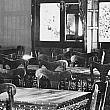Activist, Wong Chin Foo
by Andrew Hsiao
The first Asian-American New Yorker was a muckraker and a rabble-rouser. Wong Chin Foo wasn't actually the first Asian in New York--by the time he arrived here in the 1870s, there were several hundred Chinese scattered throughout the city, and Asian sailors had been part of New York's multiculti mix since the early days of the republic. But Wong was probably the first to proclaim a New World identity--Chinese American (the name of his short-lived weekly broadside, New York's first Chinese newspaper). And the bilingual Wong, self-described multinational rebel and "Heathen" missionary, was a brash champion of the Chinese during the decade when they first came to the city in significant numbers.
Wong seemed an unlikely activist to a New York Times reporter who found him holding forth at Madame Blavatsky's 47th Street apartment in April 1877. Blavatsky, the founder of the mystical Theosophy Movement, had filled her living room with stuffed bats, snakes, a tiger's head, a baboon, and a crocodile swinging from the ceiling; she called the room "The Lamasery." In his dark silk-and-velvet coats, embroidered boots and skullcap, Wong, as his chronicler Arthur Bonner puts it, "blended nicely." But he soon took to the stage to combat images of Asian exoticism and primitiveness. In a lecture at Steinway Hall, he scored the supposed barbarity of "Heathen Chinee" ways, announcing that, contrary to widespread belief, "I never knew that rats and puppies were good to eat until I was told by American people."
Wong's sharp tongue made him a kind of Victorian media activist, a quote machine for the boys of Newspaper Row. But his wit was accompanied by fearlessness. In 1883, Irish American labor leader Denis Kearney, who had led the insurgent California Workingmen's Party by wedding class-consciousness to racism (the party's slogan was "The Chinese Must Go!"), came to the city to speak at Cooper Union. Wong challenged him to a duel. "When a reporter," as Bonner recounts, "who found him smoking a cigar in the office of the Chinese American, asked him what weapons he would suggest, Wong replied: 'I give him his choice of chopsticks, Irish potatoes, or Krupp guns.' " (Kearney demurred, saying "I'm not to be deterred by the low blackguard vaporings of Chin Foo or any other representative of Asia's almond-eyed lepers.")
Wong's activism is all the more remarkable when one recalls the world of early Asian immigrants to New York. Thousands of Chinese came to the city in the late 19th century fleeing poverty and oppression--in the American West, where pogroms against the Chinese (and later Japanese, Korean, Indian, and Filipino Americans) had erupted in pandemic proportions.
But the Chinese who sought refuge in New York were greeted with a Bronx cheer. Indeed, New Yorkers had their own history of racist violence: during the bloody Draft Riots of 1863, mobs of poor Irish protesters, angry about a Civil War draft replete with loopholes for the rich, turned on colored people, burning down the Colored Orphan Asylum, lynching and mutilating blacks, and attacking the Chinese in the Fourth Ward. Then, when the first Chinese work crews were shipped East as unwitting scabs in 1870, Democratic New Yorkers responded in time-honored fashion: with a vitriolic rally in Tompkins Square. Official New York made its appearance, in the form of mayor A. Oakey Hall, a Tammany man. (Immigrant-driven Tammany had little use for Asians: denied the right to naturalize, they couldn't vote.)
Despite everything, Asian Americans fought back. One spring day in 1893, a laundryman named Fong Yue Ting, along with one of his Mott Street neighbors and another laundryman, walked up to the Federal Building and got himself arrested. Fong and his friends were making a show of their refusal to carry internal passports--photo IDs similar to the passes blacks had to have under South African apartheid. The registration law was denounced by Wong Chin Foo, whose recently-formed Chinese Equal Rights League filled Cooper Union with supporters, and Fong's case made it all the way to the Supreme Court.
In fact, the pass law challenge was just one of many. Early Asian immigrants were true Americans in at least this sense: they were intensely litigious, filing thousands of suits and arguing hundreds of appeals before the Supreme Court. Sadly, most were lost causes: within a few weeks Fong and friends were sailing to China, deported from the country that had been their home their entire adult lives.
Ghettoized Asian New Yorkers were isolated by the infamous exclusion laws; still, winds of change blew in from across the Pacific. The denial of citizenship to Asian Americans had the effect of encouraging a transnational sense of community, and Asian New Yorkers were transfixed by revolutionary goings-on in their countries of origin. When Sun Yat-sen brought his insurrectionary message to New York in 1904 (to be hailed by Wong Chin Foo among others), he began a parade of radicals arriving in the city, including anti-Japanese Korean nationalists, Indian anticolonialists, Chinese communists, Filipino anti-Marcos stalwarts, even Ho Chi Minh (who lived for a time in Harlem).
Excerpted from The Village Voice, 100 Years of Hell-Raising: The Hidden History of Asian American Activism in New York City by Andrew Hsiao, June 17 - 23, 1998

 facebook
facebook



